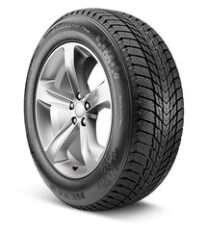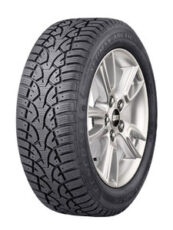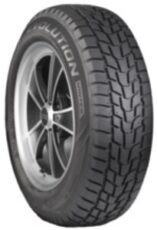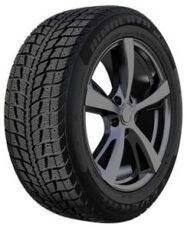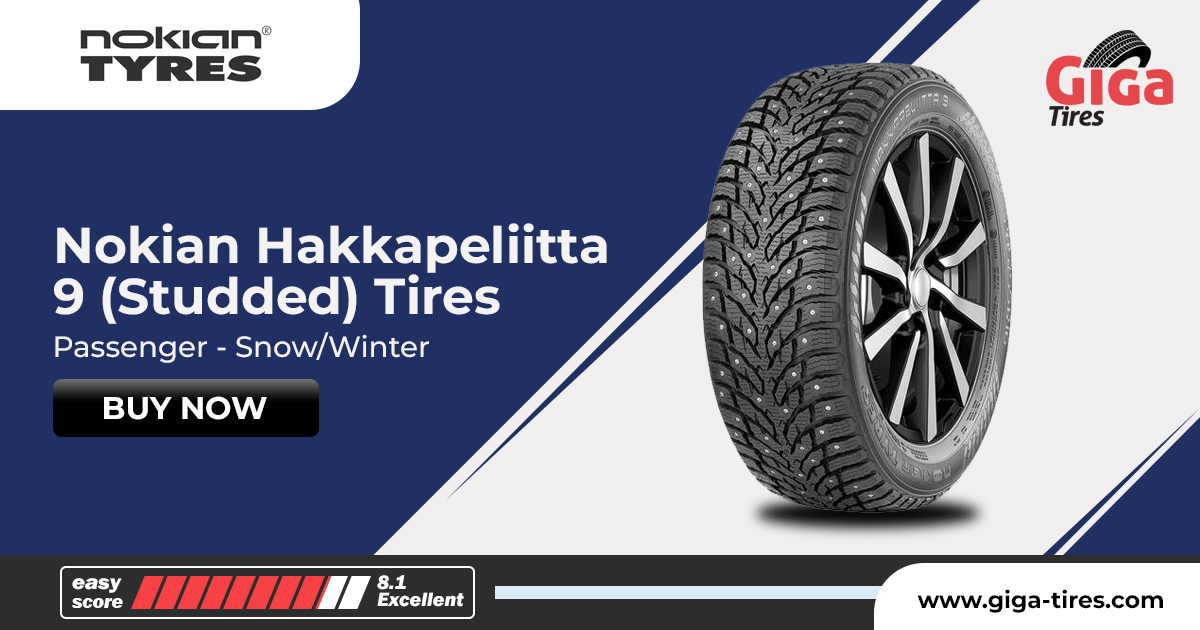Last Updated on 4 months
Understanding the Key Differences and Choosing the Perfect Winter Tires
Driving during the winter months can be downright dangerous if your vehicle is not equipped with the proper tires. While most all-season tire models are adequate for driving on winter roads, they are not designed for the best handling on ice or through thick snow.
This is why many people will wear winter tires during the colder months. Winter tires have features designed to improve grip and handling in wintry conditions by keeping the rubber pliable in cold temperatures. They also have increased stability during acceleration, everyday driving, and shorter stopping distances on snow or ice.
If you have researched winter tires, you may have noticed that they come in several different types:
- Non-studded or studless winter tires
- Studdable winter tires
- Studded winter tires
What are the differences between these tires, and which ones are best for your winter driving?
First, let’s define what truck and car tire studs are.
These are essentially like soccer cleats for your car. The tire studs are small, round pieces of metal, rubber, or plastic that dig into the ground to provide better grip, primarily for driving on ice. You can also find hard rubber-studded winter tires, but the majority of studded winter tires on the market are made with metal.
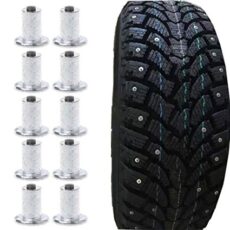
If you are in the market for new winter tires, you may wonder whether you need non-studded, studdable, or studded ones. Each has pros and cons; specific drivers will benefit most from the different types.
So, let’s break these three styles down to help you understand which winter tire you should buy.
1. Non-Studded Winter Tires
Non-studded winter tires – otherwise commonly referred to as just “winter tires “– are different from any other type of tire because of the specific design features that make them optimal for driving on cold roads – and through ice and snow.
Winter tires have specific rubber compounds that maintain flexibility in freezing temperatures. They have a unique feature referred to as “high sipe density.” As the winter tire remains flexible in colder temperatures, this “high density” of the biting edges provides an additional degree of traction and stability.
The sipes generally run across the tread surface and aid in controlling forward motion and reducing stopping distances. The tread blocks are designed with angles and edges that grip and pull forward as the wheel turns. As the tire pulls forward, the sipes flex open and grab the snow or ice when they come in contact with the surface. This is where the combination of hard tread angles and high-density siping enhances the tire’s performance on winter roads.
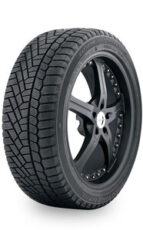 If you look at the sipes on most winter tire models, you’ll notice that they are often designed in a zig-zag pattern that opposes the tread pattern to improve the grip on water, slush, and snow to reduce the risk of slipping. Winter tires also have thick shoulder blocks on the edges of the tread to increase the amount of tire contact with the terrain and supply durability.
If you look at the sipes on most winter tire models, you’ll notice that they are often designed in a zig-zag pattern that opposes the tread pattern to improve the grip on water, slush, and snow to reduce the risk of slipping. Winter tires also have thick shoulder blocks on the edges of the tread to increase the amount of tire contact with the terrain and supply durability.
Finally, winter tires are made of specific rubber compounds that stay more pliable when temperatures drop. Summer and even all-season tires will get stiffer on cold roads, so the tread cannot flex and grip. Additionally, fewer tires may be in touch with the road surface, compromising traction. Winter tires are designed to stay soft to avoid this issue.
When to Use Non-Studded Winter Tires?
Non-studded winter tires are best for driving on roads covered in ice or snow in wet (current precipitation) or dry (extreme cold) conditions.
It’s important to note that many states prohibit metal-studded winter tires, as they can cause damage to the roads. That said, using non-studded winter tires in these states is the ONLY option for winter driving.
How to Identify Non-Studded Winter Tires?
Identifying non-studded winter tires is super easy. All you need to do is make sure the tire is classified as a winter tire; if it doesn’t have studs or any places to put studs in (pinned for studs), is it a classic winter tire?
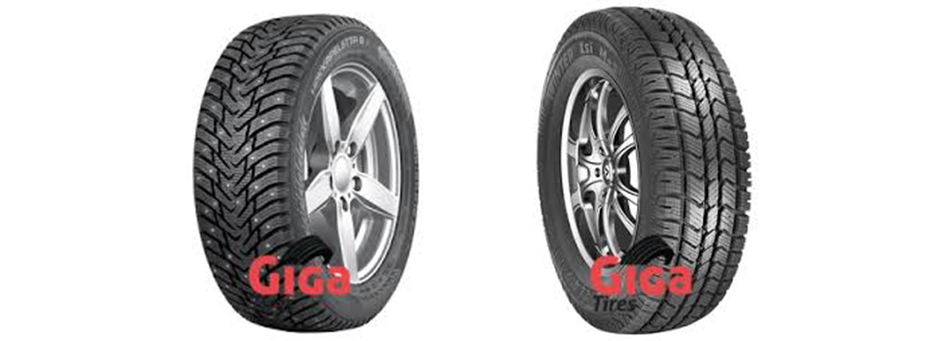
Pros of Non-Studded Winter Tires
Studless winter tires provide many benefits for drivers living in areas with light snowfall and where temperatures commonly dip below freezing.
Non-studded winter tires tend to provide a quieter ride than studded winter tires, and according to a study from Blizzak, studless winter tires had a shorter stopping distance on ice and packed snow than studded and all-season tires.
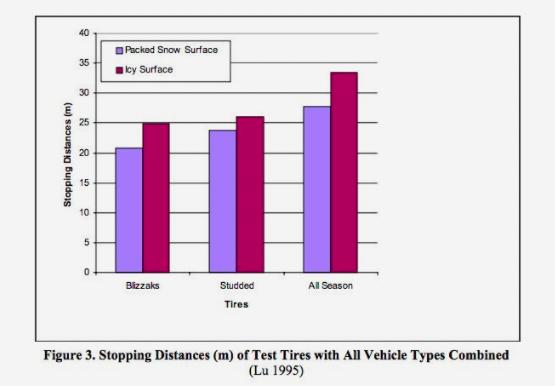
Cons of Non-Studded Winter Tires
Non-studded winter tires have some limitations, specifically regarding highly icy and slippery roads.
Although the technology of non-studded winter tires has come a long way in improving grip on treacherous winter roads, they cannot simply dig into ice as studded winter tires can.
If you look at the restrictions on studded winter tires, you’ll notice that many states that allow them – year-round or during certain times of the year – are mountainous. That said, while a non-studded winter tire will do well in the colder months, a studded tire might be ideal if you commonly drive on steep, icy inclines in states that experience harsh winter conditions.
Best Non-Studded Winter Tires
1. Continental Extreme Winter Contact
The Continental Extreme Winter Contact tire comes with the Mountain/Snowflake symbol, which means it has been approved for severe snow service.
Pricing starts at $96.36/tire.
2. Nexen Winguard Ice Plus
This one is among the best models for a non-studded winter tire. It is made with the latest compound technology to stay soft and pliable in frigid temperatures for better braking and handling. It is also built with compact, siped tread blocks for the best grip on icy, wet, or hard, dry roads.
This great budget-friendly choice comes in multiple sizes for passenger vehicles, light trucks, and SUVs. This model uses a 3D block tread for more even wear, a long-lasting tire, and WinGuard Ice Plus technology to keep the rubber compound pliable for safe driving on snowy roads.
This tire also comes with the 3-peak Mountain Snowflake symbol for severe snow service.
Pricing starts at $42.36/tire.
2. Studdable Winter Tires
Studdable winter tires are the hybrid option between studless and studded. Studs can be screwed into the predrilled holes in the tread of these tires and removed. When added studs are used, these tires can provide excellent traction on snow and heavy ice but can be cleared for less treacherous roads.
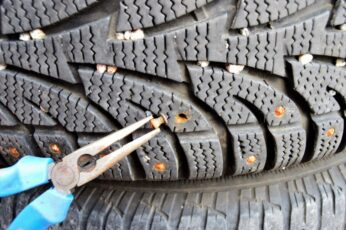
When to Use Studdable Winter Tires?
Since studdable winter tires are made for driving in snow and ice, they can be used in just about any winter road condition. Studs should be added when driving in extreme wintry conditions with frequent snow and ice, in states that permit them. Places like Montana, Colorado, New Hampshire, Wyoming, and Canada are ideal for studded or studdable winter tires.
The studs must be removed when the weather gets warmer and the roads are wet.
A non-studded, high-traction tire would be best for drivers who live in a location that experiences a mixed bag of extreme and moderate winter conditions – like around Lake Tahoe.
How to Identify Studdable Winter Tires?
When studs are not in place, a studdable tire will be easily identified by the molded holds or pins for the optional studs to be screwed into. Studdable treads, except for the pin holes, will likely appear similar to a studless winter tire.
Pros of Studdable Winter Tires
One of the most apparent benefits of having a studdable tire is getting the best of a studded and non-studded winter tire rolled into one. This gives you the flexibility to add metal studs when needed and remove them when they are not.
This can be highly beneficial if you drive your vehicle in different states, as some states have outlawed studded tires entirely due to the damage they cause on paved roads. Other states require specific permits or only allow rubber studs.
Having a stable option, you can remove studs when necessary to comply with local laws.
Cons of Studdable Winter Tires
The only real con to a studdable tire is the inconvenience of removing or adding studs to the tires. This can be pretty time-consuming as each stud needs to be individually mounted into the holes in the tire. There are typically between 80 to 100 studs on each tire.
Additionally, the ride will be rougher and louder when studs are in – and you might experience lower fuel economy due to increased rolling resistance.
Best Studdable Winter Tires
1. Cooper Evolution Winter Tire
This tire is a top pick for studdable options because the pin holes help create a shorter braking distance on slippery surfaces and improve traction even when studs are not installed. This tire also comes in multiple sizes to fit most passenger cars, light trucks, and SUVs on the road.
This tire has the 3-Peak Mountain/Snowflake symbol for severe snow service.
Pricing starts at $66.62/tire.
2. Federal Himalaya WS2
This model is another top choice for winter driving – thanks to its unique intersecting grooves and quality rubber compound that maintains grip, no matter the cold-weather condition. The multi-pitch tread reduces noise on icy roads and ensures precise handling.
The V-shaped grooves increase the tread’s rigidity and, combined with the wide ribs, propel snow and water to prevent hydroplaning on slick surfaces.
The Federal brand is a top budget-friendly choice, and this model comes in sizes for passenger vehicles, CUVs, and SUVs.
This tire has the 3-Peak Mountain Snowflake rating.
Pricing starts at $45.29/tire.
3. Studded Winter Tires
Studded winter tires are built with small rivets (the studs), which are permanent tread features. They are best for driving over ice and thick snow since these studs dig in for extra grip, similar to soccer cleats digging into turf.
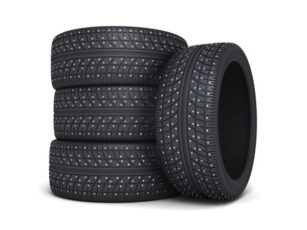
Types of Studs Used
Primarily, tire studs are metal. However, a few types of tires have plastic or hard rubber studs.
Metal studs are more muscular and can easily chip the ice underneath them. However, they can also cause more damage to paved roads, which is why many states have outlawed them.
Rubber and plastic studs are not quite as muscular, but they will cause less damage and are permitted in more states than metal ones.
How to Identify Studded Winter Tires?
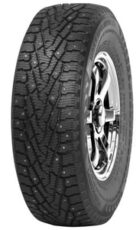 Studded winter tires are easy to spot, as the metal studs are easily visible.
Studded winter tires are easy to spot, as the metal studs are easily visible.
Since these are winter-only tires, they will likely have similar features to a non-studded winter tire – like high sipe density and biting edges.
When to Use Studded Winter Tires?
Studded winter tires are meant for driving in extreme winter conditions – they perform best on rough ice and heavy snow.
They are also designed for optimal performance in colder temperatures at or below seven °C (45 °F).
Studded winter tires are best on inclines, downslopes, and flat surfaces. The studs are meant to break the ice layer or packed snow and prevent slippage.
Laws for Studded Winter Tires in Different States
As mentioned before, some states have regulated the type of studded winter tires allowed. Some have banned them during certain months of the year, while others have banned them altogether.
The only states that permit studded winter tires to be driven year-round are Alaska, Colorado, Kentucky, New Hampshire, New Mexico, Vermont, and Wyoming.
If you are considering purchasing studded winter tires, check out the local and state laws regarding their use on the road.
How do Studs work on Snow Surfaces?
The reason why studded winter tires work so well on snowy surfaces is quite scientific.
The studs are designed to use the vehicle’s weight and centrifugal force to provide better traction. This increases the pressure on the metal studs on the snowy or icy surface, so the studs dig into the terrain for improved grip.
Pros of Studded Winter Tires
No question, studded winter tires will give your vehicle the best grip and traction in deep snow and on thick ice.
So, if you want peace of mind for extreme winter driving, a studded snow tire would be the best choice (if your state permits it)
Cons of Studded Winter Tires
There are several downsides to the studded tire, most notably the restrictions placed by the majority of states in the US.
These winter tires are primarily designed for extreme winter driving. Studded winter tires are not as safe as non-studded winter tires when driving on paved roads since the studs interfere with the friction and reduce the tires’ grip.
Studded winter tires are also extremely noisy when driving on cleared roads due to the metal hitting the pavement. This can also wear out the studs faster and damage the streets.
Best Studded Winter Tires
1. Nokian Hakkapeliitta 8 Studded
This tire is designed as one of the best and safest studded models for driving in severe winter weather. It has a top-of-the-line rubber formulation and reinforced center ribs for superior stability.
The tire also has an open groove tread pattern, which, in addition to the studs, provides ultimate grip and traction on wet and dry roads. This tire is sized for sedans, SUVs, coupes/and economy vehicles.
This tire comes with the 3-Peak Mountain/Snowflake symbol.
Pricing starts at $95.41.
2. Nokian Hakkapeliitta 9 Studded
This tire model is the newest in the famed Nokian Hakkapeliitta line. It offers unbeatable traction in a wide range of winter conditions – making it ideal for those who live in areas where the winter can be unpredictable.
This tread proudly features open grooves, sipes for biting edges, and highly pliable tread rubber to manage those sub-zero-degree temperatures. With the studs, this tire will keep you safe in almost every winter scenario imaginable!
This tire comes with the 3-Peak Mountain/Snowflake symbol.
Pricing starts at $111.98.
Key Differences Customers Must Know
There is no clear answer on whether a studded snow tire, studless snow tire, or studdable snow tire will be the best choice for your vehicle. Each tire type has something to bring to the table, and the best pick depends on the weather you will be driving in.
To help you make your decision, keep these critical differences in mind:
Non-studded or studless winter tires are best for typical winter conditions, including light snow, ice, and slush. This tire relies on its design and rubber compound for grip and traction. While these tires will perform impeccably in winter conditions, they might struggle to outperform studded in EXTREME winter conditions.
Studdable winter tires are a great choice if you will be driving in both moderate and extreme winter weather, or will be driving in states that do and don’t permit studded winter tires. This tire type offers you the best of both worlds. However, installing and removing the studs can be a time-consuming process.
Studded winter tires are designed for superior performance on dangerously icy roads or through thick snow. However, they are heavily restricted and are not best suited for driving on normal paved roads, so they should only be used when necessary.
Contact our knowledgeable staff with more questions regarding these winter models. We are here to help you learn and guide you toward the best winter tires for your vehicle.
Conclusion
When it comes to winter driving safety, choosing the right tires is paramount. We’ve explored the differences between studded, studdable, and non-studded winter tires to help you make an informed choice. Whether you prioritize maximum traction on icy roads, prefer the flexibility of studdable tires, or opt for non-studded options for quieter rides, your decision should align with your driving needs.
Ready to equip your vehicle with the perfect winter tires for the upcoming season?
Head to Giga Tires today to explore our wide selection of studded, studdable, and non-studded winter tires. Ensure your safety and confidence on winter roads with the right tires from Giga Tires!
Curiosity piqued? Satisfy your tire-related questions by exploring more articles on Giga Tires’ website. Your tired wisdom awaits!
- Guide To Winter Tires: Top 5 Winter Tire Safety Tips
- Spotlight On GBC ATV Tires: The Admirable Innovation In ATV & UTV Tires
- Spotlight On Cars And Trucks/SUV Tires: Admiring The Most Common Types Of Tires
FAQs
Are studless snow tires better than studs?
The effectiveness of studless snow tires versus studded tires depends on the specific winter conditions and your priorities. Studless snow tires are designed with advanced rubber compounds and tread patterns that provide excellent traction on snow and ice. They are generally quieter and perform well in most winter conditions, making them a popular choice for areas with varying winter weather.
On the other hand, studded tires excel in extreme icy conditions but may be noisier on dry pavement. The choice between the two should consider your local climate and the level of winter performance you require. In regions with severe ice, studded tires may be preferable, while studless snow tires can be excellent for winter use.
Are winter tires the same as studded tires?
No, winter tires and studded tires are not the same. Winter tires, often snow tires, are designed for improved traction in cold and snowy conditions. They can come in both studded and studless variants.
Studded tires have metal studs embedded in the tread to enhance grip on ice, while studless winter tires rely on advanced rubber compounds and tread designs to provide traction in various winter conditions. So, while studded tires are a type of winter tire, not all tires have studs.
When not to use studded tires?
Studded tires should not be used in certain situations. First, they are not recommended for use on dry pavement because the metal studs can cause excessive road wear and loud noise. Additionally, many states and regions have specific regulations regarding studded tires, often limiting their use to particular months or banning them entirely due to road preservation concerns. It’s essential to check local rules and remove studded tires when the season or road conditions no longer require them.
Are studded tires overkill?
Whether studded tires are overkill depends on your location and driving needs. In regions with mild or infrequent winter weather, studded tires may be unnecessary and cause increased road noise and wear when used on dry pavement.
However, studded tires can provide invaluable traction and safety in frequent and severe icy conditions. The decision should be based on your area’s specific winter conditions and driving priorities.

